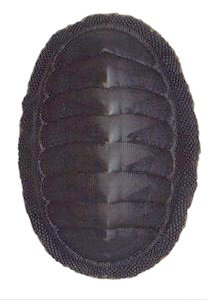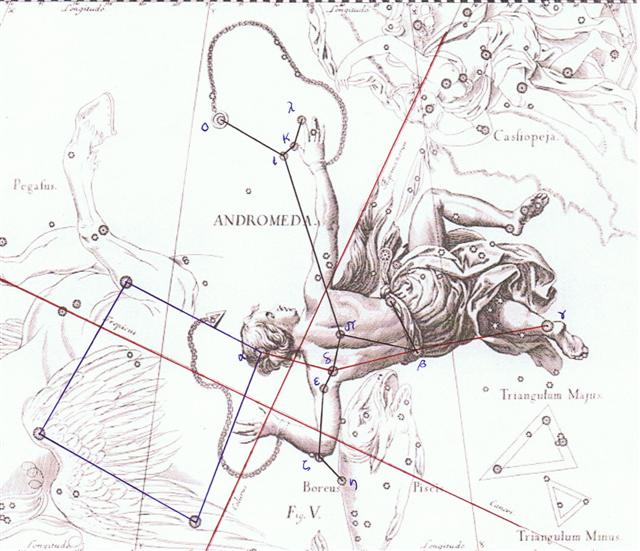Cb13-10 has been 'underlined' by Metoro as te mamahia and the odd design has 4 internal curved lines, which - I suggest - perhaps could refer to those 4 years which are to be counted (hia) before 1 or 22 leap days should be inserted:
 |
 |
| mama |
Cb13-10 |
The design of Cb13-10 could refer to a sector in a cycle. If this is a correct interpretation, then this cycle could perhaps be defined from 22 leap days and the whole cycle be around 50 days (which coincides with day 50 = February 19):
| April 10 (100) |
313 |
18 |
19 (50) |
20 |
 |
 |
 |
 |
| *Ca14-23 |
Cb13-9 (700) |
Cb13-10 |
Cb13-11 |
| kua heheu |
kua vero |
te mamahia |
te vero |
| Ksora (20.1), γ Phoenicis (20.8) |
Rooftop-12 |
ι Pegasi (335.0), Alnair (335.1), μ Piscis Austrini, υ Piscis Austrini (335.3), Woo (335.7), Baham, τ Piscis Austrini (335.8) |
ζ Cephei (336.2), λ Cephei (336.3), -/270 Lac. (336.7), λ Piscis Austrini (336.8) |
| 22h (334.8) |
| Kae Uh (334.0), Al Kurhah (334.4), SADALMELIK (334.6), ι Aquarii, ν Pegasi (334.7) |
50 = 22 + 28. The mama glyph Cb13-10 is irregular in shape and could be a way to say 'mixed descent' - partly curved and partly not. 22 could refer to 22h and 28 to 4 weeks.
The true value of π is slightly more than 314 / 100 and counting from *Ca14-23 the completed π day should be at April 19.
| Mama 1. To chew. 2. To mouth-feed (arch.) he-mama i te vai tôa koia ko te tiapito kiroto ki te haha o te poki, she mouth-feeds the child with sugarcane juice together with tiapito juice. 3. A sea mollusc (with an eight-horned shell). Vanaga.
1. To leak, to ooze, (maamaa). P Pau., Mgv., Ta.: mama, id. 2. To chew. P Mgv., Mq., Ta.: mama, id. 3. Light not heavy, (maamaa). P Mgv., Ta.: mama, id. 4. A limpet (Chiton magnificus). Mgv., Mq., mama, a shellfish. 5. To open the mouth; hakamama, to yawn, to gape, to be ajar. Pau.: hamama, to open. Mgv.: akamama, to burst open. Ta.: haamama, to open. Mq.: haámama, to open the mouth. 6. Ta.: mama-orero, conclusion of a council. Ha.: mama, to finish, to have done with a thing. Churchill. |
Chiton magnificus is a black limpet and indeed has markings on its shell:

Its shell could therefore be a suitable representation of a day 'zero' - a night outside the regular calendar. Glyphs with lines across probably indicate darkness'
Limpets are firmly attatched to stones and in that respect they resemble Andromeda, who was unable to move because she was chained to a rock:

At the beginning of time only Raven was moving while the rest of the world was sleeping, this I have learned from Robert Bringhurst's A Story as Sharp as a Knife. The Classical Haida Mythtellers and Their World:
|
Aanishaw tangagyanggang, wansuuga. |
Hereabouts was all saltwater, they say. |
|
Li xitgwaangas, Xhuuya aa. |
He was flying all around, the Raven was, |
|
Tigu qqawgashlingaay gi lla quaangas. |
looking for land that he could stand on. |
|
Qawdihaw gwaay ghutgwa nang qaadla qqaayghudyas, |
After a time, at the toe of the Islands, there was one rock awash. |
|
llagu qqawghaayghan llagha lla xiidas. |
He flew there to sit. |
|
|
|
Aa ttl sghaana quiidas yasgagas ghiinuusis gangaang |
Like sea-cucumbers, gods lay across it, |
|
llagu gutgwii xhihldagahldiyaagas. |
putting their mouths against it side by side. |
|
Ga sghaanagwaay ghaaxas lla ttista qqaa sqqagilaangas, |
The newborn gods were sleeping, out along the reef, |
|
ttl gwiixhang xhahlgwii at wagwii aa. |
heads and tails in all directions. |
|
Ghaadagas gyaanhaw ising ghaalgagang, wansuuga ... |
It was light then, and it turned to night, they say ... |
The heads and tails of the Gods were in disorder, i.e. it was a time outside the orderly calendar - Light with its shadows had not yet arrived, there was only a mixture (koia):
| March 21 |
22 (81) |
23 |
| September 20 |
21 |
equinox (265) |
| no glyph |
 |
 |
| Ca1-1 |
Ca1-2 |
| koia |
ki te hoea |
| Al Fargh al Thāni-25 |
Uttara Bhādrapadā-27 / Wall-14 |
χ Pegasi (2.1), θ Andromedae (2.7) |
| 0h (365.25) |
| Caph, SIRRAH (0.5), ε Phoenicis (0.8) |
ALGENIB PEGASI (1.8) |
| 12h (182.6) |
Pálida (184.6), Megrez (184.9) |
Hasta-13 / Chariot-28 |
| Alchita, Ma Wei (183.1), Minkar (183.7), ρ Centauri (183.9) |
GIENAH (185.1), ε Muscae (185.2), ζ Crucis (185.4), Zaniah (185.9) |
Calendar time zero was evidently beginning with April 1, we should remember, in which case March 22 becomes day 354 + 1 = 355, probably in a way corresponding to the last day of the old pre-Julian calendar:
| 24 |
Al Fargh al Mukdim |
Fore Spout |
α Pegasi (Markab), β (Scheat) |
349 |
March 5 (429) |
10 |
338 |
| 25 |
Al Fargh al Thāni |
Rear Spout |
γ Pegasi (Algenib), α Andromedae (Sirrah) |
0 |
March 21 (445) |
16 |
354 |
| 3 manazil (lunar stations) |
| |
|
Delta |
δ Andromedae |
8.4 |
March 29 (88) |
- |
- |
| 0 |
- |
Zero |
η Andromedae |
11.4 |
April 1 (91) |
- |
0 |
| 1 |
Al Sharatain |
Pair of Signs |
β Arietis (Sheratan), γ (Mesarthim) |
27.4 |
April 17 (107) |
16 |
16 |
| |
|
Musca Borealis |
35 (Head of the Fly), 39 (Kaffaljidhma), and 41 Arietis (Bharani) |
41.4 |
May 1 (121) |
14 |
30 |
| 2 |
Al Dabarān |
Follower |
α Tauri (Aldebaran), θ¹, θ²´, γ (Hyadum I), δ (Hyadum II), ε (Ain) |
63.4 |
May 23 (143) |
22 |
52 |
| 8 manazil (lunar stations) |
| 11 |
Al Áwwā' |
Barker |
β (Alaraph), η (Zaniah), γ (Porrima), δ (Minelauva), ε Virginis (Vindemiatrix) |
191.5 |
Sept 28 (271) |
13 |
180 |
|



